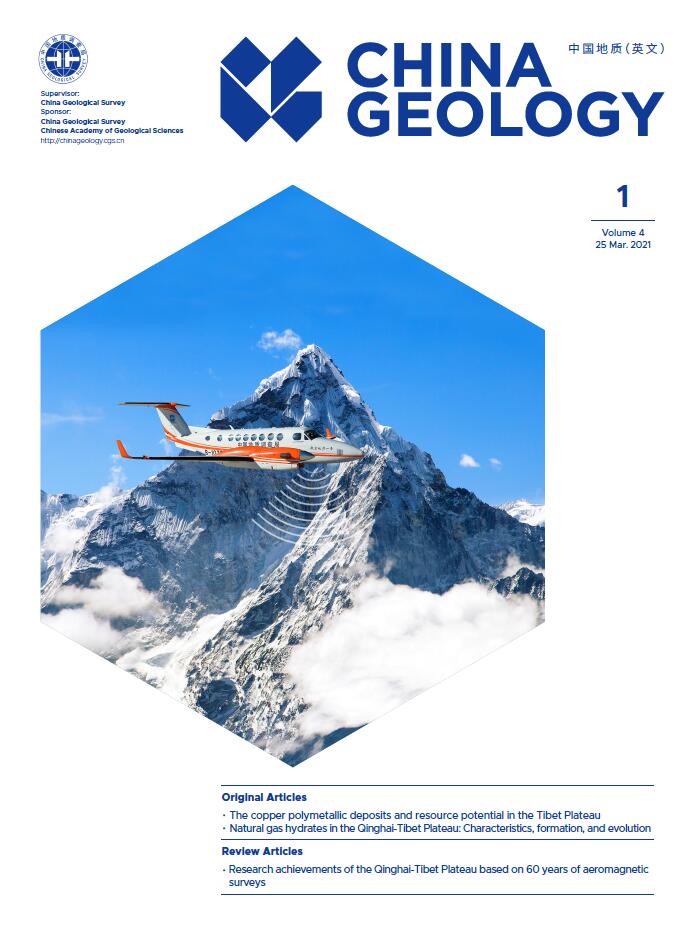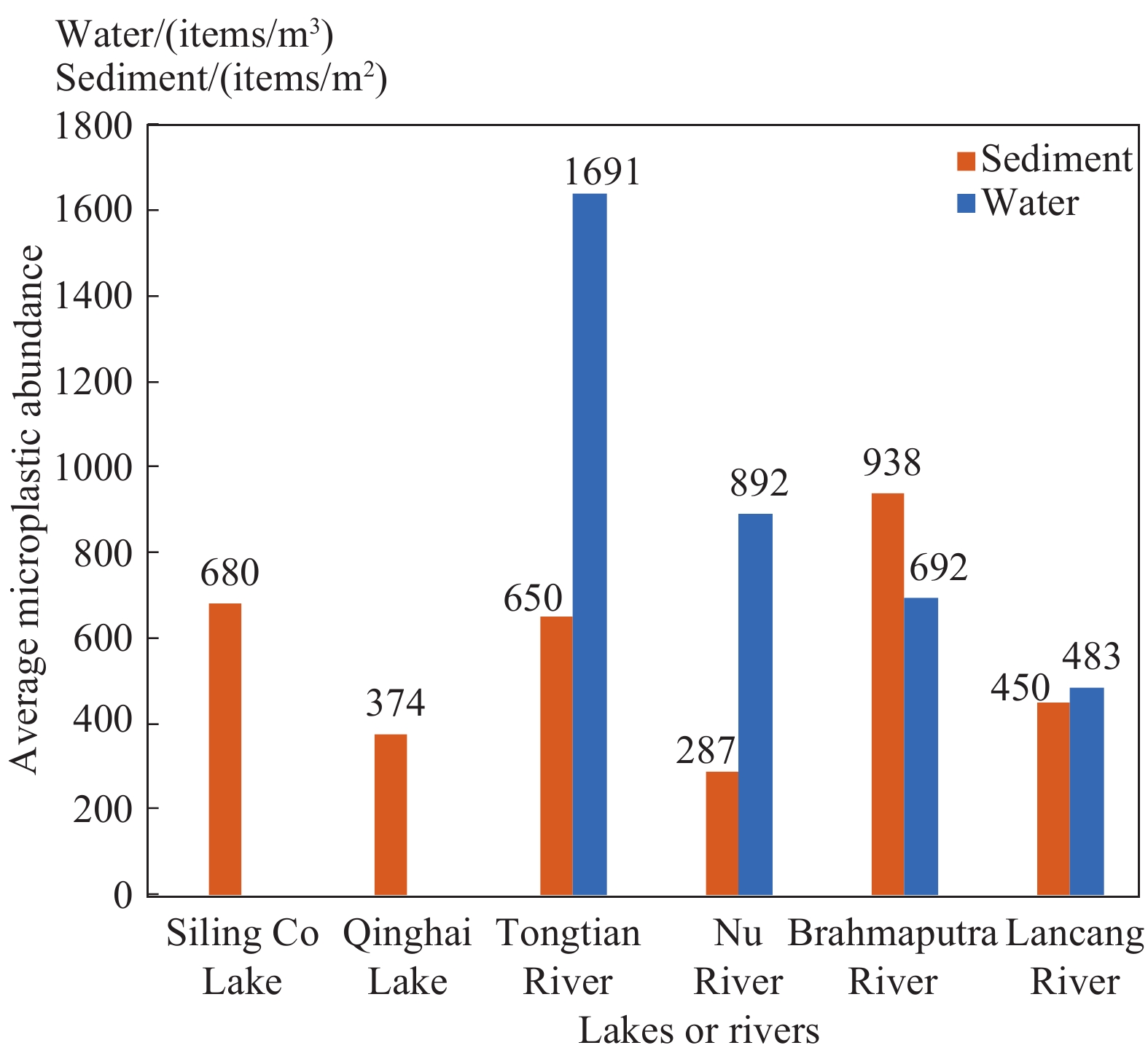| Citation: | Rui-ping Liu, Ying Dong, Guo-cang Quan, Hua Zhu, You-ning Xu, Rafaey M Elwardany, 2021. Microplastic pollution in surface water and sediments of Qinghai-Xizang Plateau: Current status and causes, China Geology, 4, 178-184. doi: 10.31035/cg2021011 |
Microplastic pollution in surface water and sediments of Qinghai-Xizang Plateau: Current status and causes
-
Abstract
To study the current status and causes of the microplastic pollution in surface water of the Qinghai-Xizang Plateau, this paper compared the average microplastic abundance in sediments and surface water of the Qinghai-Xizang Plateau and the results are as follows. First, the average microplastic abundance in surface water of the independent rivers and the whole area is 247−2686 items/m3 and 856 items/m3, respectively. The average microplastic abundance in sediments of independent rivers or lakes and the whole area is 0−933 items/m2 and 362 items/m2, respectively. Meanwhile, the degree of microplastic pollution in river sediments is higher than that in lake sediments, and the rivers suffering from microplastic pollution mainly include the Brahmaputra River, Tongtian River, and Nujiang River. Second, compared with the microplastic pollution in other areas of the world, the levelof microplastic pollution in the lakes and rivers of the Qinghai-Xizang plateau is not lower than that of well-developed areas with more intensive human activities. Finally, this study suggests that relevant government departments of the Qinghai-Xizang Plateau should strengthen waste management strategies while developing tourism and that much attention should be paid to the impacts of microplastics in the water environment.
-

-
References
Alomar C, Deudero S. 2017. Evidence of microplastic ingestion in the shark Galeus melastomus Rafinesque, 1810 in the continental shelf off the western mediterranean sea. Environmental Pollution, 223, 223–229. doi: 10.1016/j.envpol.2017.01.015. Biginagwa FJ, Mayoma BS, Shashoua Y, Syberg K, Khan FR. 2016. First evidence of microplastics in the African Great Lakes: Recovery from Lake Victoria Nile perch and Nile tilapia. Journal of Great Lakes Research, 42 (1), 146−149. http://377.rm.cglhub.com/10.1016/j.jglr.2015.10.012 doi: 10.1016/j.jglr.2015.10.012. Bordós G, Urbányi B, Micsinai A, Kriszt B, Palotai Z, Szabó I, Hantosi Z, Szoboszlay S. 2019. Identification of microplastics in fish ponds and natural freshwater environments of the Carpathian basin, Europe. Chemosphere, 216, 110–116. doi: 10.1016/j.chemosphere.2018.10.110. Chen B. 2018. Review of the source distribution and ecological effects of marine microplastics. Environmental Protection Science, 44(2), 90–97 (in Chinese with English abstract). doi: 10.16803/j.cnki.issn.1004-6216.2018.02.018. Claessens M, De Meester S, Van Landuyt L, De Clerck K, Janssen CR. 2011. Occurrence and distribution of microplastics in marine sediments along the Belgian coast. Marine pollution bulletin, 62(10), 2199–2204. doi: 10.1016/j.marpolbul.2011.06.030. Dang XY, Chang L, Lu N. 2019. The impact of climatic warm-wet situation of the Xizang Plateau on the water resources and environment in Qaidam Basin. Geology in China, 46(2), 359–368 (in Chinese with English abstract). Di M, Wang J. 2018. Microplastics in surface waters and sediments of the Three Gorges Reservoir, China. Science of The Total Environment, 616−617, 1620–1627. doi: 10.1016/j.scitotenv.2017.10.150. Donoso JM, Rios-Touma B. 2020. Microplastics in tropical Andean rivers: A perspective from a highly populated Ecuadorian basin without wastewater treatment. Heliyon, (6), 1–11. doi: 10.1016/j.heliyon.2020.e04302. Dris R, Gasperi J, Rocher V, Saad M, Renault N, Tassin B. 2015. Microplastic contamination in an urban area: A case study in Greater Paris. Environmental Chemistry, 12(5), 592–599. doi: 10.1071/EN14167. Dris R, Gasperi J, Rocher V, Tassin B. 2018. Synthetic and non-synthetic anthropogenic fibers in a river under the impact of ParisMegacity: Sampling methodological aspects and flux estimations. Science of The Total Environment, 618, 157–164. doi: 10.1016/j.scitotenv.2017.11.009. Dris R, Gasperi J, Saad M, Mirande C, Tassin B. 2016. Synthetic fibers in atmospheric fallout: A source of microplastics in the environment? Marine pollution bulletin, 104(1−2), 290–293. doi: 10.1016/j.marpolbul.2016.01.006. Fan K, Zhang Q, Singh VP, Sun P, Song C, Zhu X, Yu H, Shen Z. 2019. Spatiotemporal impact of soil moisture on air temperature across the Xizang Plateau. Science of the Total Environment, 649, 1338–1348. doi: 10.1016/j.scitotenv.2018.08.399. Fok L, Cheung PK. 2015. Hong Kong at the Pearl River Estuary: A hotspot of microplastic pollution. Marine Pollution Bulletin, 99(1−2), 112–118. doi: 10.1016/j.marpolbul.2015.07.050. Gray AD, Wertz H, Leads RR, Weinstein JE. 2018. Microplastic in two South Carolina Estuaries: Occurrence, distribution, and composition. Marine Pollution Bulletin, 128, 223–233. doi: 10.1016/j.marpolbul.2018.01.030. He L, Huang FJ, Yin KD. 2018. The ecological effect of marine microplastics as a biological vector. Journal of Tropical Oceanography, 37(4), 1–8. doi: 10.11978/2017112. Hidalgo-Ruz V, Gutow L, Thompson RC, Thiel M. 2012. Microplastics in the marine environment: A review of the methods used for identification and quantification. Environmental Science & Technology, 46(6), 3060–3075. doi: 10.1021/es2031505. Hitchcock JN, Mitrovic SM. 2019. Microplastic pollution in estuaries across a gradient of human impact. Environmental Pollution, 247, 457–466. doi: 10.1016/j.envpol.2019.01.069. Imhof HK, Ivleva NP, Schmid J, Niessner R, Laforsch C. 2013. Contamination of beach sediments of a subalpine lake with microplastic particles. Current Biology, 23, 867–868. doi: 10.1016/j.cub.2013.09.001. Jiang CB, Yin L, Li Z, Wen XF, Luo X, Hu SP, Yang HY, Long YN, Deng B, Huang LZ. 2019. Microplastic pollution in the rivers of the Xizang Plateau. Environmental Pollution, 249, 91–98. doi: 10.1016/j.envpol.2019.03.022. Kataoka T, Nihei Y, Kudou K, Hinata H. 2019. Assessment of the sources and inflow processes of microplastics in the river environments of Japan. Environmental pollution, 244, 958–965. doi: 10.1016/j.envpol.2018.10.111. Li L, Wu J, Lu J, Min X, Xu J, Yang L. 2018. Distribution, pollution, bioaccumulation, and ecological risks of trace elements in soils of the northeastern Qinghai-Xizang Plateau. Ecotoxicology and Environmental Safety, 166, 345–353. doi: 10.1016/j.ecoenv.2018.09.110. Liu GZ, Zhu ZL, Yang YX, Sun YR, Fei Y, Jie M. 2019. Sorption behavior and mechanism of hydrophilic organic chemicals to virgin and aged microplastics in freshwater and seawater. Environmental Pollution, 246, 26–33. doi: 10.1016/j.envpol.2018.11.100. Lusher AL, Tirelli V, O’Connor I, Officer R. 2015. Microplastics in Arctic polar waters: The first reported values of particles in surface and sub-surface samples. Scientific Reports, 5, 1–9. doi: 10.1038/srep14947. Martin J, Lusher A, Thompson RC, Morley A. 2017. The deposition and accumulation of microplastics in marine sediments and bottom water from the Irish continental shelf. Scientific Reports, 7, 10772. doi: 10.1038/s41598-017-11079-2. Mccormick A, Hoellein T, London M, Hittie J, Scott J, Kelly J. 2016. Microplastic in surface waters of urban rivers: Concentration, sources, and associated bacterial assemblages. Ecosphere, 7(11), 1–22. doi: 10.1002/ecs2.1556. Nel HA, Dalu T, Wasserman RJ. 2018. Sinks and sources: Assessing microplastic abundance in river sediment and deposit feeders in an Austral temperate urban river system. Science of the Total Environment, 612, 950–956. doi: 10.1016/j.scitotenv.2017.08.298. Rummel CD, Jahnke A, Gorokhova E, Gorokhova E. 2017. Impacts of biofilm formation on the fate and potential effects of microplastic in the aquatic environment. Environmental Science & Technology Letters, 4(7), 258–267. doi: 10.1016/j.jhazmat.2020.124187. Sun XY, Zhang RJ, Huang W, Sun A, Lin LJ, Xu HG, Jiang DC. 2019. The response between glacier evolution and eco-geological environment on the Qinghai-Xizang Plateau. China Geology, 2, 1–7. doi: 10.31035/cg2018078. Sruthy S, Ramasamy EV. 2017. Microplastic pollution in Vembanad Lake, Kerala, India: The first report of microplastics in lake and estuarine sediments in India. Environmental Pollution, (22), 315–322. doi: 10.1016/j.envpol.2016.12.038. Ter Halle A, Ladirat L, Martignac M, Martignac M, Mingotaud AF, Boyron O, Perez E. 2017. To what extent are microplastics from the open ocean weathered? Environmental Pollution, 227, 167–174. doi: 10.1016/j.envpol.2017.04.051. Thompson RC, Olsen Y, Mitchell RP, Mitchell RP, Davis A, Rowland SJ, John AWG, McGonigle D, Russell AE. 2004. Lost at sea: Where is all the plastic? Science, 304(5672), 838–838. doi: 10.1126/science.1094559. Van Cauwenberghe L, Vanreusel A, Mees J, Janssen CR. 2013. Microplastic pollution in deep-sea sediments. Environmental Pollution, 182, 495–499. doi: 10.1016/j.envpol.2013.08.013. Vedolin MC, Teophilo CYS, Turra A, Figueira RCL. 2018. Spatial variability in the concentrations of metals in beached microplastics. Marine Pollution Bulletin, 129(2), 487–493. doi: 10.1016/j.marpolbul.2017.10.019. Wang J, Peng J, Tan Z, Gao Y, Zhan Z, Chen Q, Cai L. 2017. Microplastics in the surface sediments from the Beijiang River littoral zone: Composition, abundance, surface textures and interaction with heavy metals. Chemosphere, 171, 248–258. doi: 10.1016/j.chemosphere.2016.12.074. Wang W, Yuan W, Chen Y, Wang J. 2018. Microplastics in surface waters of Dongting lake and Hong lake, China. Science of the Total Environment, 633, 539–545. doi: 10.1016/j.scitotenv.2018.03.211. Wang ZB, Li RH, Yang SY, Bai FL, Mei X, Zhang J, Lu K. 2019. Comparison of detrital mineral compositions between stream sediments of the Yangtze River (Changjiang) and the Yellow River (Huanghe) and their provenance implication. China Geology, 2(2), 169–178. doi: 10.31035/cg2018065. Wen X, Du C, Xu P, Zeng G, Huang D, Yin L, Yin Q, Hu L, Wan J, Zhang J, Tan S, Deng R. 2018. Microplastic pollution in surface sediments of urban water areas in Changsha, China: Abundance, composition, surface textures. Marine Pollution Bulletin, 136, 414–423. doi: 10.1016/j.marpolbul.2018.09.043. Wessel CC, Lockridge GR, Battiste D, Cebrian J. 2016. Abundance and characteristics of microplastics in beach sediments: Insights into microplastic accumulation in northern Gulf of Mexico estuaries. Marine Pollution Bulletin, 109, 178–183. doi: 10.1016/j.marpolbul.2016.06.002. Xiong X, Kai Z, Chen XC, Shi HH, Ze L, Chen XW. 2018. Sources and distribution of microplastics in China’s largest inland lake-Qinghai Lake. Environmental Pollution, 235(1), 899–906. doi: 10.1016/j.envpol.2017.12.081. Xu M, Halimu G, Zhang Q, Song YB, Fu XH, Li YQ, Li YS, Zhang HW. 2019. Internalization and toxicity: A preliminary study of effects of nanoplastic particles on human lung epithelial cell. Science of the Total Environment, 694, 1–10. doi: 10.1016/j.scitotenv.2019.133794. Yao Z, Li X, Xiao J. 2018. Characteristics of daily extreme wind gusts on the Qinghai-Xizang Plateau, China. Journal of Arid Land, 10(5), 673–685. doi: 10.1007/s40333-018-0094-y. Zhang K, Su J, Xiong X, Wu X, Wu CX, Liu JT. 2016. Microplastic pollution of lakeshore sediments from remote lakes in Xizang plateau, China. Environmental Pollution, (219), 450–455. doi: 10.1016/j.envpol.2016.05.048. Zhang S, Pan X, Lin L, Tao JX, Liu M. 2020. Preliminary study on the composition and distribution characteristics of microplastics in water from the source region of the Yangtze River. Journal of Yangtze River Scientific Research Institute, 1–8 (in Chinese with English abstract). doi: 10.11988/ckyyb.20200174. Zhang YS, Sun L, Yin XL, Meng H. 2017. Progress and prospect of research on environmental geology of China: A review. Geology in China, 44(5), 901–912 (in Chinese with English abstract). Zhao L, Li W, Lin L, Guo WJ, Zhao WH, Tang XQ, Gong DD, Li QY, Xu P. 2019. Field investigation on river hydrochemical characteristics and larval and juvenile fish in the source region of the Yangtze River. Water, 11(7), 1–20. doi: 10.3390/w11071342. Zhao S, Zhu L, Li D. 2015. Microplastic in three urban estuaries, China. Environmental Pollution, 206, 597–604. doi: 10.1016/j.envpol.2015.08.027. Zhao S, Zhu L, Wang T, Li D. 2014. Suspended microplastics in the surface water of the Yangtze Estuary System, China: First observations on occurrence, distribution. Marine Pollution Bulletin, 86, 562–568. doi: 10.1016/j.marpolbul.2014.06.032. -
Access History

-
Figure 1.
Distribution of microplastics sampling sites in rivers and lakes of the Qinghai-Xizang Plateau. The yellow spots are the sampling sites.
-
Figure 2.
Average microplastic abundance in sediments or surface water of lakes or rivers in the Qinghai-Xizang Plateau, China.





 DownLoad:
DownLoad:
